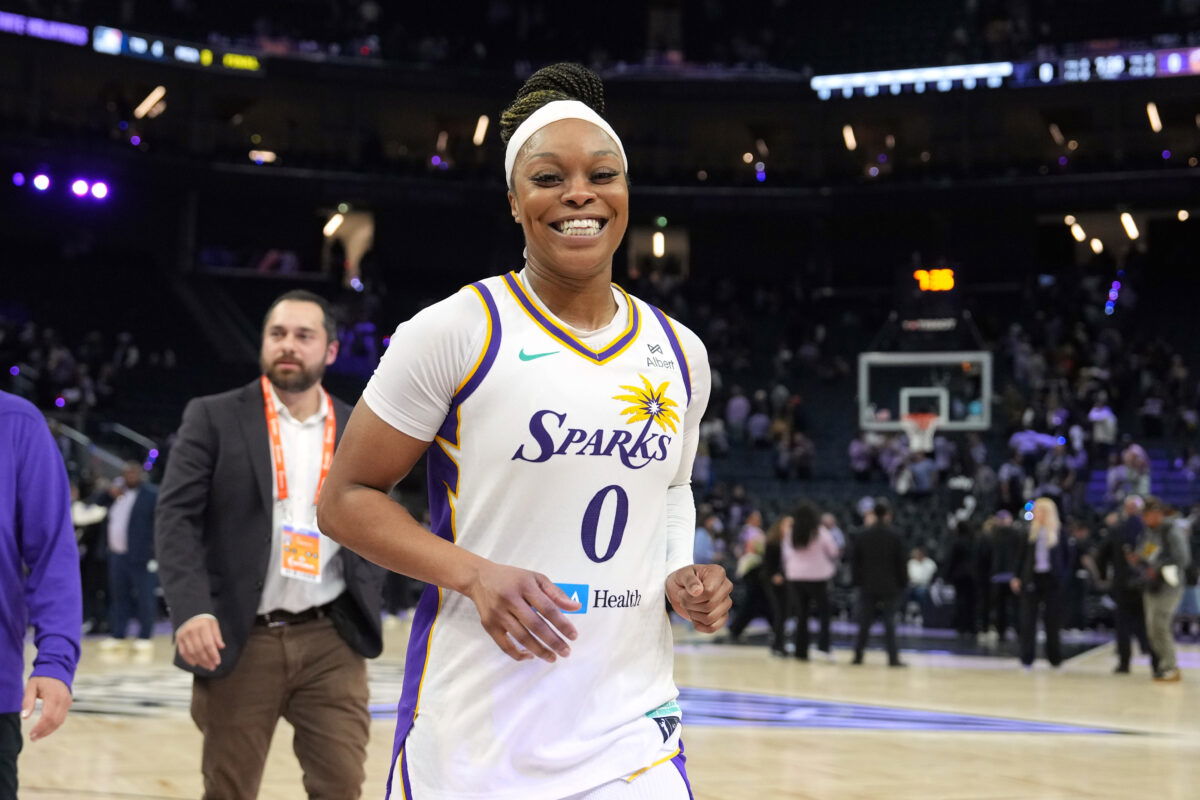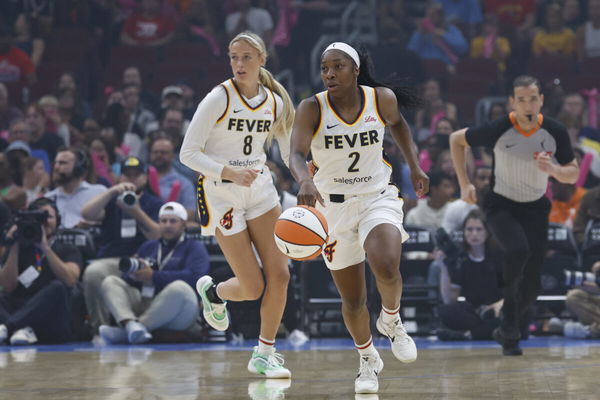
Imago
May 16, 2025; San Francisco, California, USA; Los Angeles Sparks guard Odyssey Sims (0) jogs off of the court after defeating the Golden State Valkyries at Chase Center. Mandatory Credit: Darren Yamashita-Imagn Images

Imago
May 16, 2025; San Francisco, California, USA; Los Angeles Sparks guard Odyssey Sims (0) jogs off of the court after defeating the Golden State Valkyries at Chase Center. Mandatory Credit: Darren Yamashita-Imagn Images
“It felt weird every day waking up not being in the gym or just being around my teammates,” said Aari McDonald after being signed by the Indiana Fever on a hardship contract. “But I mean, my approach is, stay ready. You never know when you’ll get the call.” And that’s what life as an in-season WNBA free agent can be like. You never quite know which city you’ll land in or how long you’ll be there. With rosters barely big enough to form a dinner party, and no comfy feeder league or cushy two-way deals like the NBA enjoys, these players have to stay game-ready year-round.
Watch What’s Trending Now!
What is a Hardship Contract in the WNBA
Well, when W teams are hit hard by injuries and rosters get thin, they have the option to use hardship contracts. While it’s not often talked about, it plays a crucial role behind the scenes, keeping teams afloat when the season gets rough. And now, with a 44-game schedule and increased injuries, these contracts are a blessing in disguise.
ADVERTISEMENT
Well, that’s because, unlike standard deals, these contracts bring a whole different energy and urgency, while opening doors for players waiting in the wings to find a temporary fix—or let’s say, an opportunity to perform and prove their worth, as Aari did when she joined the Fever.
So yes, it’s a win-win deal for both the player and the team, as well as for the injured ones—giving them ample rest is a must to ensure player safety and the league’s competitiveness at the same time. But not every team with an injured roster and every player out can get the opportunity to sign the deal!
Top Stories
Sources: John Harbaugh Wasn’t Fired, Left Ravens After Refusing Major Staff Changes

Bill Cowher’s Strong Message to Steelers on Firing Mike Tomlin After HC’s Blunt Playoff Message

Pat McAfee Can’t Hide What He Thinks About Audi Crooks Leaving NBA, WNBA Stars Behind

Bengals’ Cam Taylor-Britt Sentenced to Jail: Everything We Know About Charges Against Him

Key Takeaways: Geno Auriemma’s UConn Rolls Past St. John’s in Comfortable Win

Kyle Tucker Handed Blunt Reality Check as Blue Jays Shift Focus to Bolster Vladimir Guerrero Jr.

ADVERTISEMENT
WNBA Hardship Contract Rules and Eligibility
According to the latest collective bargaining framework, there are a few eligibility requirements that both a player and a team need to fulfill to be a match. First, the team needs to fall below 10 players on the roster, and these players must be game-eligible but could be out due to injuries, illness, or other absences.
But this isn’t the only condition—if at least two players are ruled out for a significant period, typically three weeks or more with medical confirmation, the team can apply for a hardship contract. However, that doesn’t mean you can apply the moment your player is out—another rule states that the required players must be set to miss at least one game before the hardship contract can be activated. Once a team qualifies under these rules, it can sign a 13th player on a short-term addition that doesn’t count against the standard 12-player roster limit.
ADVERTISEMENT
Indiana Fever’s Hardship Contract Usage
If there’s any team getting the most help from hardship contracts this season, it has to be the Indiana Fever. Not just because they signed Aari, but because once again, the injury bug bit the team harder than ever. Both Aari, after breaking a bone in her right foot, and Sydney Colson, after tearing her left ACL, are out for the season.
Meanwhile, Caitlin Clark—who has been sidelined since July 16 with a right groin injury—hasn’t made a comeback, adding to the list as she has already missed 18 of the Fever’s 31 games this season. So with all three players out of the roster, the Fever had no point guard available. And the worst part?
ADVERTISEMENT
It all happened on August 7, right after the trade deadline ended, so Fever had no option but to sign Odyssey Sims to a hardship contract. But, since the Fever had only nine players on the roster, the squad was eligible, and the best part of this contract is that they don’t have to waive Sims even when Caitlin Clark returns.
Also, the Fever still has another spot available to fill via hardship contract, as even after signing Sims, the squad is limited to 10 players. But if the team does so, they must release either Sims or the second hardship player once Caitlin Clark returns to the active roster.
The Fever signed Odyssey Sims on a regular hardship contract, which isn’t necessarily tied to the 10-available player rule.
The rule is confusing, but the jist of it (which is still too long to be in a single post) is this: pic.twitter.com/xTKWvWPZJR
— Chloe Peterson (@chloepeterson67) August 10, 2025
ADVERTISEMENT
So, this flexibility allows the Fever to manage their roster dynamically under the current league hardship contract rules. But, like two sides of a coin, hardship contracts have pros and cons—and while the Fever have been leveraging the pros so far, the cons may not be far off since it’s already midseason!
Advantages and Limitations for Players and Teams
Yes, hardship contracts allow teams to still field a competitive lineup when they dip below the 10-player threshold due to illness or injury. It’s also a short-term addition that keeps games fair and protects player safety by preventing teams from scrambling to field a full roster.
ADVERTISEMENT
It’s a win-win deal, as these often open the gateway for players to showcase their skills on the league’s stage, just like Aari McDonald and Chloe Bibby, who landed short-term opportunities and made meaningful contributions. As Odyssey Sims put it, “I stay in the gym even when I’m not playing. You never know when that moment is going to come,” underscoring how these opportunities reward consistent preparedness. But it’s not all roses, as these contracts are typically week-to-week. Once the original players return, those on hardship deals are let go.

Imago
Jul 27, 2025; Chicago, Illinois, USA; Indiana Fever guard Aari McDonald (2) brings the ball up court against the Chicago Sky during the first half at United Center. Mandatory Credit: Kamil Krzaczynski-Imagn Images
And while these players come to support, they aren’t always familiar with the team’s style of play and are required to adapt instantly to new systems. Coaches often scramble to integrate them, like Grace Berger, who needed extra support to catch up. Additionally, a player is only allowed to sign three hardship contracts with the same team in one season, and these contracts cannot extend into the playoffs.
ADVERTISEMENT
Historical and Recent Examples in the WNBA
Hardship contracts have been vital for quite some time in the W, even though they’re often a complex mechanism. They enable teams to manage unexpected talent gaps. Historically, players like Layshia Clarendon from the Minnesota Lynx back in 2021 stepped in during injury crises and earned a full-season deal after proving their value. She’s not alone—Nikolina Milic and Jennie Simms also navigated multiple hardship stints before earning longer-term opportunities.
The 2025 season is no exception. Even expanding rosters like the Golden State Valkyries have leaned on short-term pickups like Kaila Charles amid injuries and international absences. And the Fever? We already know how they paired up with Aari McDonald, who was credited with stabilizing the backcourt during her stint.
ADVERTISEMENT
Months later, the team’s in a similar situation, just with a few changes. This time, it’s veteran Odyssey Sims helping the Fever with depth and experience. The former All-Star averaged 9.8 points, 2.9 rebounds, and 3.5 assists on 35.3% shooting from 3-point range in her 12 appearances with the Sparks this season.
ADVERTISEMENT
ADVERTISEMENT
ADVERTISEMENT

